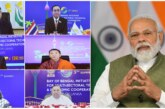When two giant countries, in terms of population and resources, join hands for mutual friendship and cooperation, better prospects for global peace and prosperity do emerge. India and China have had ancient civilizational contact. In recent times, the process of development and diversification of bilateral relations has gathered momentum. The focus is on enhancing mutually beneficial cooperation while simultaneously addressing differences, as well as contributing to peace, stability and prosperity in the least developing regions.
Trade and Economic Relations
Being ancient civilizations sharing common geographic proximity, India and China had some economic interaction in ancient times. The post-Second World war period witnessed revival of economic ties between the two countries, though on a small scale, during the decade of 1950s. Domestic and regional geopolitical compulsions obtaining in the decades of the 1960s and the 1970s proved instrumental in cooling-off political and economic interaction between India and China.1 India and China resumed trade officially in 1978. In 1984, the two sides signed the Most-Favoured-Nation Agreement.
Both India and China responded positively to the priorities of the post- Cold War changes by opening up their economies, though China preceded India in its effort to liberalise its economy in as early as 1978 under the ambitious programme of Four Modernizations.2 Since early 1990s, both the countries have expedited the process of integration in the global economy as well as bilateral economic cooperation. However, comparative figures for both the countries indicate China’s superiority in several sectors.
The mutual grant of the Most Favoured Nation (MFN) treatment has increased Sino- Indian bilateral trade. On February 22, 2000 China agreed to accord India on a non-reciprocal basis, tariff concessions on a number of items as part of its pre-WTO entry signal. But bilateral trade between both the countries was not as impressive as during the period from April to October 1999 were it totalled $965 million against $853 million in the corresponding months of 1998. The trade balance was tilting consistently against India.
Burgeoning economic ties between the world’s two fastest growing economies have become the most salient aspect of the bilateral relationship. Mutually beneficial economic ties could provide a cushion in times of crisis over future nuclear and military security issues. Bilateral trade has been rising rapidly from US$350 million in 1993 to nearly US$7 billion in 2003 and exceeded US$10 billion in 2004. In 1994, India displaced Pakistan as China’s largest trading partner in South Asia, and in 2003 China displaced Japan as India’s largest trading partner in East Asia. There is talk of India and China eventually signing a free-trade agreement to create the largest market with more than 2 billion people.
Many Chinese companies are keen to form joint ventures (JVs) with India’s information technology (IT) industry while Indian manufacturing companies stand to benefit from JVs with China’s consumer goods industries. China’s electric consumer goods companies like Hai’er and Konka and India’s IT and pharmaceutical companies such as Infosys, NIIT, Satyam, Ranbaxy, and Dr. Reddy’s have established some presence. Several JVs in power generation, consumer goods, steel, chemicals, minerals, mining, transport, IT, and telecommunication are in the pipeline.
Bilateral Institutional Mechanisms
There are several institutional mechanisms for India’s economic and commercial engagement with China. India-China Joint Economic Group on Economic Relations and Trade, Science and Technology (JEG) is a ministerial-level dialogue mechanism established in 1988 during the visit of former Prime Minister Rajiv Gandhi to China. A Joint Study Group (JSG) was set up after former Prime Minister Vajpayee’s visit to China in June 2003 to examine the potential complementarities between the two countries in expanded trade and economic cooperation. As per its recommendation, a Joint Task Force (JTF) was set up to study the feasibility of an India-China Regional Trading Arrangement. JTF Report was completed in October 2007. There are also Joint Working Groups on Trade, Agriculture and energy. The two countries also cooperate in the WTO.3
Bilateral Trade
The overall bilateral trade figures for 2010 released by the China Customs are shown in
Table-1: (All figures in US$ billions)
| Category | 2008 | 2009 | 2010 |
| India Exports to
China |
20.34 | 13.70 | 20.86
|
| Growth % | 38.76 | -32.63 | 52.19 |
| China Exports to
India |
31.52 | 29.57 | 40.88
|
| Growth % | 31.12 | -6.17 | 38.25 |
| Total India-China
Trade |
51.86 | 43.28 | 61.74
|
| Growth % | 34.02 | -16.55 | 42.66 |
| Trade Balance for
India |
-11.18 | -15.87 | -20.02
|
Source: India, Ministry of External Affairs, “India-China Relations”, January 2011, available at http://meaindia.nic.in/meaaxpsite/foreignrelation/china.pdf
It is observed from table-1 that total trade between India and China crossed the target of US$ 60 billion for 2010 and stood at US$ 61.74 billion, recording an increase of more than 52%. India’s exports to China for year 2010 reached US$ 20.86 billion, a growth of more than 52% when compared to year 2009. However, India’s exports to China in 2010 were only slightly more than the figure for year 2008 when our exports reached US$ 20.34 billion. India’s exports in 2010 recorded an increase of only 2.5%. On the other hand, China’s exports to India for year 2010 reached US$ 40.88 billion, registering an increase of almost 41% compared to 2009. The trade deficit for India for year 2010 stood at more than US$ 20 billion, more than US$ 15.87 billion trade deficit in year 2009.
Bilateral investments
Chinese Investment in India
2007- US$16 million
2008- US$49.1 million (Cumulative investment till Dec 2008 was at US$91.1 million)
Jan-Sep, 2009- US$ 32.7 million.
Indian Investment in China
2006 – US$52 million
2007- US$ 34 million in 78 Projects
2008- US$257 million in 92 projects (turnover realized was US$88.1 million and the cumulative committed FDI from India into China in the projects till 2008 wasUS$898 million in 426 projects)
Jan-Sep 2009- 30 million in 57projects.
Chinese Project Contracts in India
2007- US$4.56 billion ( turnover realized in 2007 was US$1.99 billion)
2008- US$12.9 billion (turnover realized from these projects during 2008 was US$4.3 billion)
Jan-Sep 2009- US$ 6.4 billion ( Turnover realized is at US$ 4.4 billion)
Cumulated value of Contractual Chinese investment (Projects) till June 2009 is US$ 29.6 Billion. The overall turnover realized from these projects till June 2009 is about US$11 billion.4
Indian Companies in China
Indian business presence in China is in a range of operations including manufacturing (pharmaceuticals, refractories, laminated tubes, auto-components, wind energy etc.), IT and IT-enabled services (including IT education, software solutions, and specific software products), trading, banking sector (major Indian banks from the public and private sector are present in China), and trade and industry associations including CII and FICCI. Air India also has an online station in China. The vehicles for the presence of Indian companies in China are joint ventures with the Chinese partners, wholly owned foreign subsidiaries or through contract manufacturing.
Some of the prominent Indian companies in China include Ranbaxy, Orchid Pharmaceuticals, Dr. Reddy Laboratories, Aurobindo Pharma, NIIT, Bharat Forge, Infosys, TCS, Satyam Computers, APTECH, Orind Refractories, Essel Packaging, Suzlon Energy, State Bank of India, Bank of India, Punjab National Bank, Canara Bank, ICICI Bank, Bank of Baroda, Reliance Industries, KGK Diamonds, Sundaram Fasteners etc. The total number of Indian companies is slightly over 100.5
Chinese Companies in India
Many large Chinese State-owned companies in the field of power generation, machinery and infrastructure construction have won projects in India and most of these companies also have a presence in India. These include Sinosteel, Shougang International, Baoshan Iron & Steel Ltd, Sany Heavy Industry Ltd, Chongqing Lifan Industry Ltd, China Dongfang International, SinoHydro Corporation etc. Many Chinese companies into electronics, IT and hardware manufacturing are also based in India. These include Huawei Technologies, ZTE, TCL, Haier etc. Major Chinese projects in India are in the field of infrastructure construction, including roads and bridges, power projects, including EPC and also supply of heavy equipment, industrial projects mainly in the iron and steel sector, including boilers, turbines and pelletization plants, as well as telecommunications. Table-2 provides data cooperative agreements along with their contents between India and China on key deals for the improvement of economic cooperation between the two countries.
Table-2: Improving the economic partnership – Key deals
| Type of cooperation/agreement | Content |
| China Development Bank & Reliance
Power Limited [Anil Dhirubhai Ambani Group] |
Over a billion dollars in financing ($1.1 billion)
to the Sasan power project in Madhya Pradesh (4,000 mw coal-fired power generation project) from Chinese banks for procurement of equipment from Shanghai Electric Corporation. Bank of China, China Development Bank and the Export-import Bank of China along with Standard Chartered Bank comprise the consortium of this financing arrangement. |
| Industrial and Commercial Bank of
China [ICBC, the world’s largest lender by market value] and China Development Bank with ICICI Bank |
Approximately $ 1.5 billion financing
agreement |
| China Development Bank & Reliance
Communications [Anil Dhirubhai Ambani Group] |
A $1.93 billion agreement [70% of the loan to
repay debt for launching 3G services; remaining to buy mobile network equipment from Chinese vendors Huawei and ZTE] |
| Shandong Electric Power Construction
Corporation [SEPCO-III] and Shandong Tiejun Electric Power Engineering with the Adani Group |
A $3.63 billion agreement for supply of power
Equipment |
| Dongfang Electric Corp and Abhijeet
Projects |
Supply of power equipment worth $2.5 billion
for thermal power projects |
| Bank of China and the IDBI Bank | A $1.2-billion facility arrangement |
| Shandong and the Tamil Nadu Power
Corporation |
Supply of $800 million worth of power
Equipment |
| China Aluminium International &
Vedanta Aluminium |
Metal imports worth $330 million |
| Huawei telecom | Investment of $2 billion in a new research
facility in Bangalore; manufacturing unit in Chennai |
| SinoSteel | Setting up an integrated steel plant in West
Bengal [1 million tonne capacity per annum] |
| The Reserve Bank of India & China
Banking Regulatory Commission |
MoU to increase banking and financial
cooperation; permission for banks to open branches and representative offices |
| Export-Import Bank of India and China
Development Bank Corporation |
MoU to increase banking and financial
cooperation |
| SRM Energy & China Datang | Financing a 2,000 MW power project at $1.4
Billion |
Source: Compiled by the author from media reports
Re-balancing of the Indian deficit (roughly USD 20 billion) from its trade with China has been promised through enhanced trade facilitation in the pharma and IT/Engineering sectors, a proposed CEO’s forum, more openness to Indian agro products, greater presence in Chinese trade fairs, and the desire for a strategic economic partnership. The present focus on infrastructure financing in India through Chinese banks is demonstrative of a ‘win-win’ situation for both sides. China’s consumer price index (CPI), a key measure of inflation, hit a two-year high of 5.1 per cent year-on-year in November 2010. Meanwhile, the People’s Bank of China (PBOC; the equivalent of the RBI in India) raised banks’ reserve requirement ratio (the deposits mandated to be withheld) for the sixth time in 2010 as a sterilization measure to prevent excess money supply from adding to inflation.6 Under such circumstances, Chinese banks have been foraying into lending operations elsewhere as well (Industrial and Commercial Bank of China’s (ICBC) commercial property loan in summer 2010 to a group led by private-equity firm, the Carlyle Group, in the United States is a case in point)
The push for horizontal investments from China i.e. market seeking FDI through local production seems to have received less attention. This is an area which needs to be explored fully to address employment generation in India, and for Chinese firms to have a visible household presence in India (similar to Korean and Japanese consumer durables, for instance).
Presently, China is more deeply entrenched in the economic architecture of the world. China’s concern to develop its Western regions coupled with diminishing incentives to foreign investors on the East Coast implies a patient and consistent effort at domestic restructuring in China. The stimulus measures and other construction projects need to be absorbed, the idea of “soft infrastructure” over “hard infrastructure” i.e. transparency and corruption-control has to be pushed through, and inequity needs to be tackled both between cities and rural areas, and between provinces in China. That is a long-drawn process of reforming social security and healthcare in China, apart from administrative reforms relating to land and labour rights.
Viewed in a broad spectrum, the prospects of relying on Europe and the United States as consumer markets for China over the long term are dicey owing to low growth rates in the latter economies because an economy growing at 8 to 10 per cent could hardly rely on markets that grow at between 2 and 3 per cent in the long run. The existing incompatibility in the growth trajectories of India and China is attributed to the market-first approach in China vis-à-vis the business-first approach in India’s liberalization of its economy. Virtually as a visible aftermath, China is a larger trading nation even as the private sector there is yet to benefit from lenient financial intermediation. The State in Chin still plays a big role even today.
India, on the other hand, has a promising private sector and vibrant secondary markets even as its integration into the global economy is hindered by comparatively higher tariff barriers in the country. The absence of intersection in the key growth drivers of both countries (Industry versus Services in China and India, respectively) actually presents the most important reason for India to work with China, and for China to work with India. The economic imperatives for China to engage with the larger Asian region are borne out by the trends in consumption expenditures in this region.
China presently is entangled in the need to revive consumption expenditure internally, in order to offset the export-dependent economic engine of its growth. One report indicates the role that Asia stands to play as an alternate consumer market in the long term.7 The resilience of the middle class in Asia during the 2008-09 recession is highlighted by an estimated USD 4.3 trillion in annual expenditures during the crisis.8 This was nearly a third of the private consumption in OECD countries, and is projected to account for 43 per cent of the worldwide consumption in 2030.
Conclusion
India and China have better prospects of promoting mutual economic growth and development if their economic ties are not ‘securitized’, and the issue of tariff (from India’s side) and non-tariff barriers (China’s side) and protectionism (both countries) is addressed. Business-to-business relations can be encouraged through the increase in frequency of visits of business delegations to both sides. Besides, both countries can have joint ventures in third countries on mutually agreed terms. Presently, both India and China are engaged in cooperative efforts in some of the African countries to promote trade and economic relations. New Delhi and Beijing should avoid any kind of competition or rivalry in Africa because it will wrong impression to the native African countries which strongly detest any sort of neocolonialism.
It seems advisable for both countries to form China-India Forum for Africa in which representatives of both sides, including business and banking representatives, should identify countries for individual investment and joint investments. Increased economic and commercial interaction between New Delhi and Beijing also augurs well for South Asia to help Bangladesh, Nepal, Bhutan, Maldives, Afghanistan and Sri Lanka to promote economic development. In this manner, China-India cooperation can bring peace, stability and prosperity in South Asia, to begin with, and in the world in the long run.
Notes
- For background information on India-China relations see Bhawna Pokharna, India-China Relations: Dimensions and Perspectives, Delhi: Saujanya Books, 2009.
- For details see, Michael Yahuda, Towards the End of Isolation: China’s foreign Policy after Mao, London: Macmillan, 1983.
- India, Ministry of External Affairs, “India-China Relations”, January 2011, available at http://meaindia.nic.in/meaaxpsite/foreignrelation/china.pdf .
- Gordon G. Chang, “China’s Galloping Inflation”, Forbes, 12 December 2010, at http://blogs.forbes.com/gordonchang/2010/12/12/chinas-galloping-inflation/.
- Asian Development Bank, “The Rise of Asia’s Middle Class”, in Key Indicators for Asia and the Pacific 2010, Philippines: Asian Development Bank, August 2010, p. 283.
By Dr. Arvind Kumar President India Water Foundation



